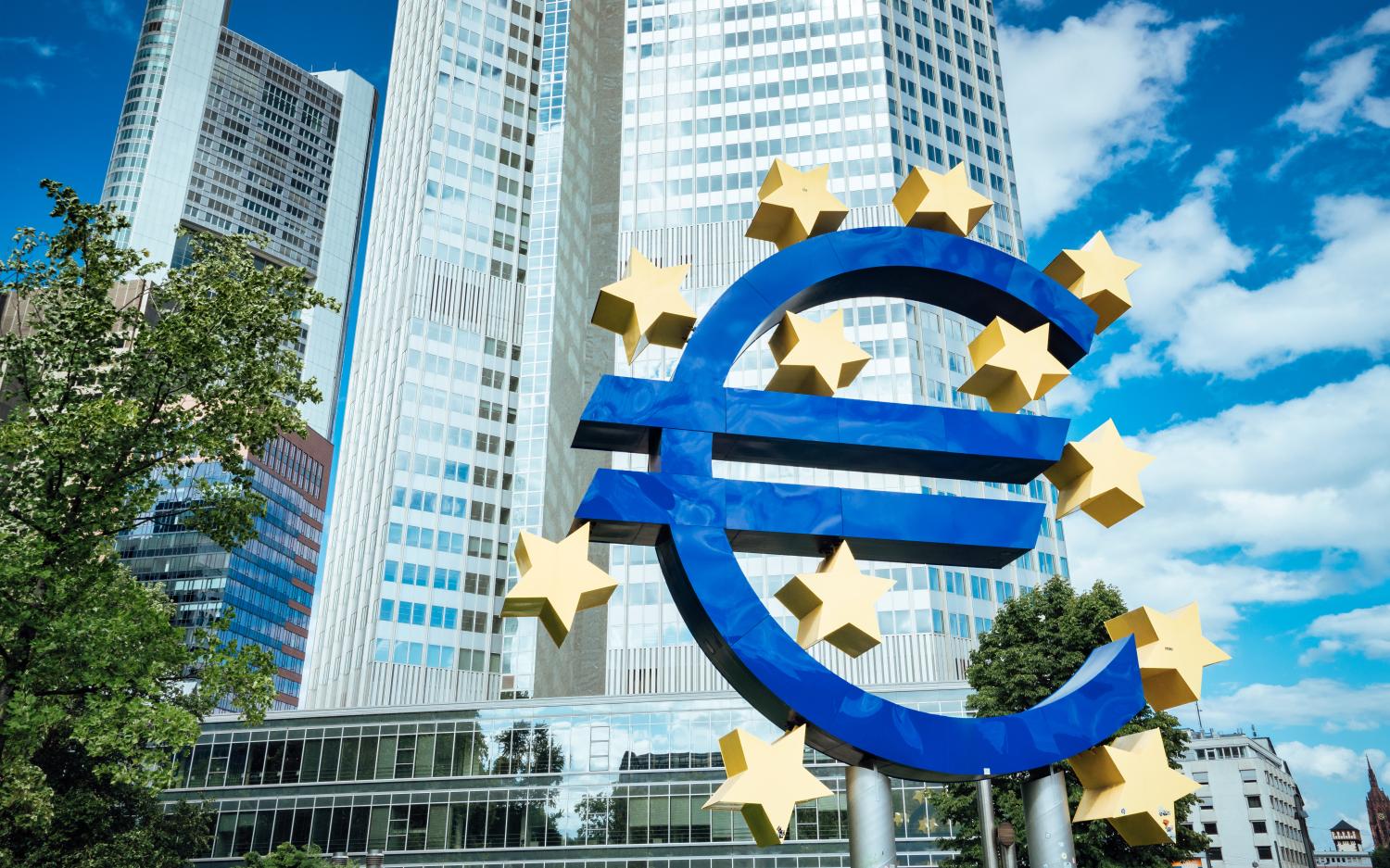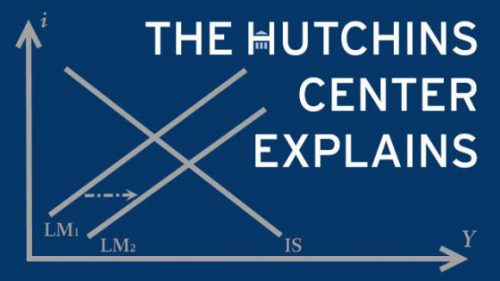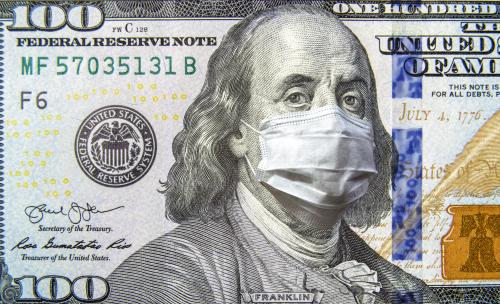This post was most recently updated on June 4, 2020. For a summary of what the U.S. Federal Reserve has done in response to the coronavirus pandemic, check out this post.
The European Central Bank (ECB) is the analog to the Federal Reserve for the euro area, the 19 European nations that share a common currency, the euro. Its primary mandate, set by treaty, is to maintain price stability. It also supervises 115 major banks in the eurozone, which account for more than 80 percent of all banking assets.
The eurozone economy differs from the U.S. in important respects. In contrast to the U.S., there is no eurozone-wide fiscal policy and there is no eurozone-wide government bond akin to the U.S. Treasury bond. In addition, a much larger fraction of all credit (about 80 percent of the total) in the eurozone goes through the banking system because Europe’s capital markets aren’t as large or robust as those in the U.S. (where banks account for only 20 percent of the financing for non-financial corporations).
Like the Fed, the ECB has responded to the COVID-19 pandemic by pledging to lend freely and stepping up its purchases of government debt. “Extraordinary times require extraordinary action,” said Christine Lagarde, the ECB president. “There are no limits to our commitment to the euro. We are determined to use the full potential of our tools, within our mandate.” But the governance of the ECB and the political environment in which it operates differ from those of the Fed, and at times have complicated the ECB’s response to the crisis.
How does governance of the ECB differ from the Fed?
The ECB’s Governing Council sets policy for the eurosystem. It consists of six members of the Frankfurt-based Executive Board (including the ECB President) plus the governors of the 19 national central banks (NCBs) that are members of the currency union. (Only 15 of the NCB presidents have votes at any meeting under a rotation that resembles the one used by the presidents of the Fed’s regional banks.) So a majority of the 21 votes at any Council meeting belong to governors of the NCBs. Those from heavyweights like the German Bundesbank or the Banque de France hold great sway in policy decisions, and generally are not expected to defer to the ECB President. As explained below, the national central banks also play a different role in central bank asset-buying than the regional Federal Reserve banks do.
What is the ECB doing to support the euro area economy?
Negative interest rate policy. Unlike the Fed, which had room to cut interest rates in response to the COVID-19 crisis, the ECB’s policy rate has been negative since 2014, when it was cut below zero to nudge banks to lend, rather than leaving deposits at the central bank. The deposit facility, the rate that banks receive for depositing at the ECB, is currently at minus 0.50 percent. But under a policy called ‘tiering,’ banks do not have to pay this penalty rate for a substantial proportion of their deposits. The ECB also controls two other short-term rates at which the banks can borrow from the ECB: the main refinancing operations and the marginal lending facility. These rates are largely irrelevant, however, as these facilities are rarely used today because the ECB has supplied liquidity in other ways. The ECB has not lowered any of its key rates since the onset of the pandemic. (The Fed has said that negative rates are not an appropriate policy response for the U.S.)
Forward guidance. The ECB has offered forward guidance on the future path of its key interest rate, saying that they expect rates will remain “at their present or lower levels until it has seen the inflation outlook robustly converge to a level sufficiently close to, but below, 2 percent within its projection horizon, and such convergence has been consistently reflected in underlying inflation dynamics.” Such forward guidance on the overnight rate puts downward pressure on longer-term rates.
Asset purchases (Quantitative Easing or QE). Prior to the COVID-19 crisis, the ECB was purchasing about €20 billion each month in government bonds, regional and local authorities’ bonds (roughly akin to municipal bonds in the U.S.), corporate bonds, asset-backed securities, and covered bonds under the existing Asset Purchase Program (APP). The aim was to push inflation up to its target. In response to the crisis, on March 12, the ECB announced it would buy an additional €120 billion under the APP.
Post-COVID asset purchases. On March 18, the ECB launched the €750 billion Pandemic Emergency Purchase Program (PEPP), which will last until the coronavirus crisis period is over but, in any case, at least until the end of 2020. The assets to be bought under the PEPP are mostly the same: the biggest chunk goes to national and regional government bonds, including for the first time Greek sovereign debt, supra-national debt, and various types of private sector bonds. Unlike the APP, it will also buy commercial paper issued by non-financial corporations. The PEPP is “exceptional,” designed specifically “to address the issue of the pandemic,” the ECB said. On June 4, the ECB increased the maximum size of its purchases of government bonds under PEPP by €600 billion to €1350 billion and extended the horizon for those purchases at least to the end of June 2021. The ECB also emphasized that it wants to maintain flexibility in the purchases across asset classes and among jurisdictions.

Under the APP, the purchases of government bonds were scaled in proportion to how much capital each country’s national central bank contributes to the ECB, known as the capital key. In practice, the capital key reflects each country’s population and contribution to the overall GDP of the euro area.
While the PEPP will continue to follow this rule on average, the ECB has said that it intends to distribute the PEPP purchases in a “flexible” manner—essentially implying that at times it may deviate from the capital key and that it might put aside an old rule that it cannot buy more than one-third of any member country’s outstanding debt.
Some eurozone economies entered the crisis in stronger fiscal positions than others. In Germany, for example, government debt amounted to about 60 percent of its gross domestic product (GDP) in 2019, while in Italy debt equaled 135 percent of GDP and is now expected to go over 155 percent of GDP. The COVID crisis hit Italy early, and contributed to an increase in yields on Italian government debt (often measured as the spread, or difference, in yields on safe German debt and riskier Italian debt). Through the PEPP, the ECB aimed, in part, to reduce this widening spread. While the bond purchases do reduce government borrowing costs, ECB officials have said that the asset purchases are aimed at preventing destabilizing runs on government bonds and ensuring that easy monetary policy gets shared equally across the eurozone.
In a surprise decision in early May, the German constitutional court threatened to prevent the Bundesbank from participating in sovereign bond purchases. Formally, the ruling was only on an old complaint concerning ECB purchases under the APP. The court said that the program doesn’t properly balance the ECB’s price stability objective with its responsibility to support the European Union’s “general economic policies,” and told the Bundesbank to stop participating in the program unless the ECB can prove otherwise. The court took note of the ban, written into European Union treaties, that forbids the central bank from directly financing government spending, known as ‘monetary financing.’ It said that sticking to the capital key and limiting bond purchases to one-third of any one nation’s debt was a way to avoid violating that prohibition.
One reason for the controversy is the perception—mistaken—that the ECB’s bond-buying is transferring risk from countries like Spain and Italy to Germany and the Netherlands. Because of the structure of the central bank in Europe, that’s not so.
The NCBs carry out operations to implement the ECB’s policies, much as regional Reserve Banks conduct operations on behalf of the Federal Reserve Board in the U.S. In the U.S. system, the Reserve Banks share one balance sheet and thus the gains and losses on their assets. In the euro area this is also the case for most ‘conventional’ monetary policy instruments, but the government bond-buying programs are important exceptions. Under these programs, NCBs buy the bonds of their own governments and hold them on their own balance sheets, meaning that any potential losses on the assets will not be shared across the eurozone.
Difference in balance sheet structure. About 80 percent of the assets on the Fed’s balance sheet are securities issued by or guaranteed by the U.S. government. Swap lines with other central banks account for another 6 percent. Lending to the banks is most of the remainder. In contrast, at the ECB, securities of all kinds comprise about 60 percent of the total portfolio and lending to banks (almost all long-term operations) account for close to 20 percent, and the rest is a mix of other assets.
Incentivize banks to lend. The ECB on April 30 expanded its targeted long-term refinancing operations (TLTROs) in response to the COVID-19 crisis. In TLTROs, the ECB offers to banks cheap, long-term loans with incentives to use the funds to lend to euro area consumers and businesses. Banks can now borrow for three years at an interest rate of minus 0.5 percent; furthermore, banks that lend above a certain threshold to businesses and consumers will pay an interest rate as low as minus 1 percent. In other words, the ECB is paying banks to borrow money from the central bank in the hopes that this will encourage them to lend money. The amount banks may borrow is also linked to how much they lend to the economy. The ECB has raised the maximum amount a single bank can borrow from 30 to 50 percent of the bank’s outstanding consumer and business loans. Initial uptake has been low, however, since profitable lending opportunities are scarce during a pandemic.
What else is the ECB doing to support the euro area economy and financial markets?
In its roles as the eurozone’s main bank supervisor and lender of last resort, the ECB has taken actions to increase banks’ lending capacities and to support funding markets.
Temporarily relaxed capital requirements. The ECB on March 12 announced that banks can use the capital and liquidity buffers they have accumulated in recent years to lend to consumers, businesses, and other banks. In its statement, the ECB emphasized that European banks have built strong capital position to withstand shocks like COVID-19 and are now able to support the economy. This change amounts to €120 billion in new capital that can be used to absorb losses or finance up to €1.8 trillion of lending. Banks are expected to use their additional capital to support the economy and not to increase dividends or share buybacks at least until October 2020. In addition, the ECB is considering rescheduling stress tests and extending deadlines for remediation actions from previous supervisory tests.
Forbearance. The ECB on March 20 relaxed the rules around which loans must be classified as “non-performing loans.” Typically, banks must follow stringent rules when they make loans: they should only lend to customers who are able to repay the loans and must track the loan’s performance. Understanding that during COVID-19 even prime borrowers may temporarily have trouble paying back their loans, banks now have more flexibility on what loans classify as non-performing. In addition, banks can set aside less capital to cover losses from non-performing loans; the more money that banks set aside to cover associated losses, the fewer funds they have available to make other loans.
Eased collateral restrictions. When the ECB extends loans to banks through TLTRO or other refinancing programs, it takes high-quality collateral from the banks to ensure it will get paid back. To make participating in the programs easier for banks, the ECB broadened the array of assets it will accept as collateral, initially on April 7 and expanded on April 22. The ECB now accepts as collateral an expanded set of non-marketable assets—including government guaranteed loans, lower quality loans, and small business loans—that are outside of the general framework. It also granted waivers to Greek sovereign debt, which, because of its non-investment grade status, was not previously considered eligible collateral. ‘Fallen angel’ bonds, those that have recently lost their investment-grade rating, are now accepted as collateral as well. In addition, the ECB reduced haircuts, the amount of collateral required in excess of the loan amount, for its lending programs. In effect, the ECB decided that it is willing to temporarily increase its risk tolerance so banks can access the ECB’s liquidity operations. However, in contrast to the Fed, all the ECB’s lending facilities are full recourse, meaning the commercial bank must pay if the collateral turns out to be worthless.
Support for bank funding and money markets. Markets for short-term borrowing have frozen or tightened in some parts of the world as investors and banks have hoarded cash during the crisis. A run in the funding markets can destabilize the financial system and be costly to the real economy. In an effort to prevent this from happening in Europe, the ECB will lend to banks through its long-term refinancing operations (LTROs) at negative interest rates. In early March, the ECB announced that it would conduct LTROs until the end of June. But as the crisis deepened, the ECB on April 30 announced the pandemic emergency long-term refinancing operations (PELTROs), which will provide liquidity to banks and money market funds through September 2021. PELTROs allow banks with loans not eligible for the TLTRO, such as mortgage loans and loans to public entities, and banks that have exhausted TLTRO limits, to continue to access cheap liquidity. Banks participating in PELTROs will benefit from the collateral easing measures, too.
International swap lines. Using a tool created during the global financial crisis, the ECB can exchange euros for foreign currencies and lend those currencies to banks in the euro area. The re-established swap lines with central banks in Canada, England, Japan, Switzerland, and the U.S., and extended the swaps to central banks of Bulgaria, Croatia, and Denmark (these lines were not activated as there was little stress in euro money markets). Because of the role the U.S. dollar plays in international banking, the ECB’s swap line with the Federal Reserve is especially important. The pandemic has put stress on the U.S. dollar funding market, and European banks have found it difficult to obtain U.S. dollars. The ECB is offering weekly U.S. dollar operations with 1-week maturity and 84-day maturity at interest rates slightly above the overnight rate. European banks borrowed $130 billion within days after the swap line was reopened.
What impact have these ECBs actions had on financial markets, lending and the euro-zone economy?
It is too early to tell whether the ECB’s actions will stabilize the economy. In Europe’s bank-centric system, market interest rates play only a limited role. Banks appear hesitant to increase lending, despite all the cheap funding the ECB is providing, because demand for credit is weak and they see few viable projects as the economic outlook remains so uncertain. The euro area’s banking system seems solid for the moment. The Achilles heel of Europe’s financial markets remains the high level and risky nature of (national) government debt. Risk spreads have come down since the announcement of the PEPP, but, especially for Italy, they remain higher than they were before the crisis. Like the Fed, the ECB has averted a spiraling financial crisis, but might not be able to do much to speed up the recovery.

What else might the ECB do?
Interest rates are likely already as negative as they can go, and there is the concern that rates which are too negative would not help the economy.
The recent judgment of the German constitutional court has narrowed the room for maneuver of the ECB in terms of government bond buying, but ECB officials say they are prepared to expand the size and scope of the PEPP anyhow. The ECB could still buy more private sector assets, where it has more flexibility than in buying debt of national governments, and could even buy equities (which the Fed says it cannot legally buy).
If a country such as Italy lost access to global bond markets, there is another tool—Outright Monetary Transactions—but the ECB cannot use this one unilaterally. Under OMT, the ECB could buy potentially unlimited amounts of a nation’s government bonds on the secondary market—but only if the country first came to an agreement to borrow from the European Stability Mechanism—an international financial institution set up by eurozone governments to aid eurozone countries in financial distress. Borrowers would have to agree to conditions on their economic policies that national governments are likely to resist unless they have no alternatives.
The authors did not receive financial support from any firm or person for this article or from any firm or person with a financial or political interest in this article. None of the authors is currently an officer, director, or board member of any organization with a financial or political interest in this article. Unrelated to this piece, Gros and Capolongo recently received financial support from Deutsche Bundesbank for a separate grant project on potential future monetary policy instruments for the European Central Bank.
The Brookings Institution is committed to quality, independence, and impact.
We are supported by a diverse array of funders. In line with our values and policies, each Brookings publication represents the sole views of its author(s).












